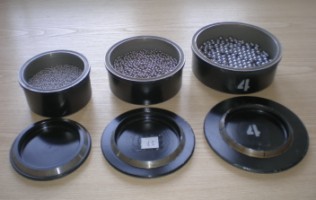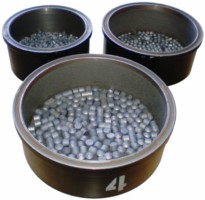Linings and grinding media
Particular milling conditions: linings and atmosphere. Steel jars and steel milling bodies are often used for grinding of many materials. At these milling conditions some quantity of fine ferrous particles is necessarily generated. Therefore some amount of Fe can be found in the treated material after milling. If required it is possible to decrease the ferrous contamination. At particular conditions it can be as low as 0.2 w. % of Fe.
However for a number of materials including ceramics even such low amount of iron is unacceptable. In this case ceramic linings and ceramic milling bodies must be used.
There are various linings and milling bodies available from manufacturers of planetary mills. The materials of these linings and milling bodies include silicon nitride and carbide, aluminium and zirconium oxide, natural jasper, hard alloys (tungsten carbide/cobalt), chrome-nickel-alloy steel, rubber, polyurethane. Nevertheless there is one more problem: ceramic balls may not withstand impact loads exerted in high energy density planetary mills. According to the literature data grinding bodies of zirconia possess high wear resistance. Since ceramic linings and milling bodies are manufactured and supplied on the by-order basis they are quite expensive. To mill tungsten carbide (WC) and other components of hard alloys we use hard metal grinding media.
In planetary mills powders are subjected to activation and acquire high reactivity. If milling is performed in the atmosphere of air the treated materials can undergo oxidation. If this is undesirable it is necessary to provide inert gas atmosphere in the jars. Charging and discharging of the powders is performed in a glove box filled with inert gas (argon).
|

Active-nano (Andrey V. Petrov)




